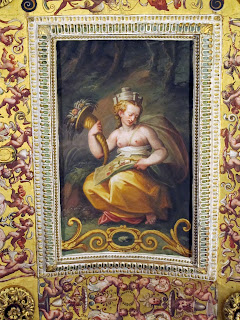 |
| Funerary monument to Sir John Hawkwood, 1436, photo courtesy of Wikipedia Creative Commons |
A most interesting biography in Giorgio Vasari’s The
Lives of Artists, the life of Paolo
Uccello, recounts a somewhat downtrodden life for the artist. Vasari writes at length about what he
calls Uccello’s preoccupation with perspective, who spent less time on his
figures, which often come out stiff. He admires Uccello’s talent, but writes that “anyone who
does violence to his nature with fanatical study may well sharpen one corner of
his mind, but nothing that he creates will ever appear to have been done with
the nature ease and grace of those who place each brush-stroke in its proper
place”. According to Vasari,
Uccello lived a rather impoverished and lonely life, locking himself in his home
due to his own embarrassment and lack of praise.
 |
| Uccello's Mazzochio drawing, photo courtesy of Wikipedia Creative Commons |
Though
Paolo Uccello was perhaps distracted with the mathematical perfection of his
art, it allowed for a great improvement in the techniques of perspective – a
fact which presents itself in his artwork. Mazzochios, a wicker
headdress fashionable for men in his day, are found in many of Uccello’s
paintings. While many artists
would focus on the humanity and realism within an artwork, Uccello did
extensive drawings on these mazzochios, striving to understand their structural complexity and perspective.
 |
| Vasari's fresco for the Earth element in Palazzo Vecchio, photo by Tessa B. |
Uccello
also often employed the terra verde
(generally, earth toned) style of painting in many of his pieces. This sometimes frustrates Vasari, who
states that it is an error “because things that appear to be made from stone
cannot and should not be tinted with another color”. In other words, Uccello often painted buildings or nature in
unnatural colors, a practice that Vasari does not quite understand.
In
all, Vasari seems to have admired Uccello for his talents. Interestingly enough, it seems he
borrowed an idea from Uccello’s frescos in the Peruzzi home for one of the
rooms commissioned by Duke Ferdinand in the Palazzo Vecchio: the four elements
painted with animals representing them, a mole for the earth, a fish for water,
a salamander for fire, and a chameleon for air.
No comments:
Post a Comment